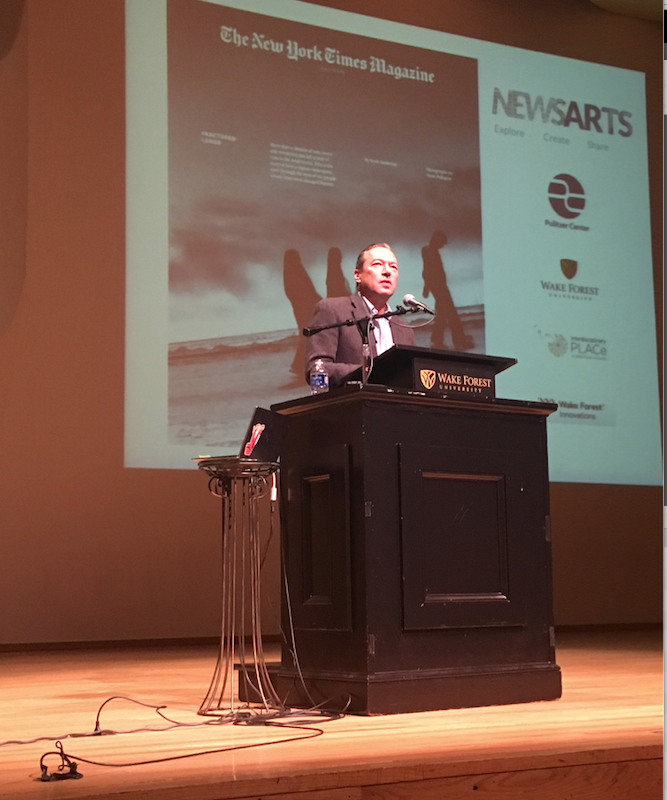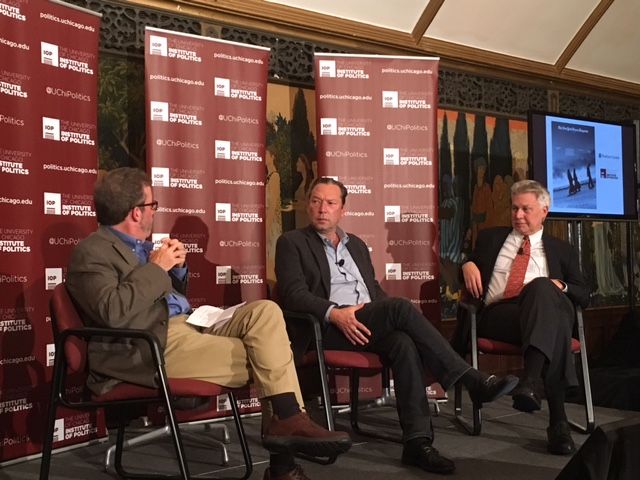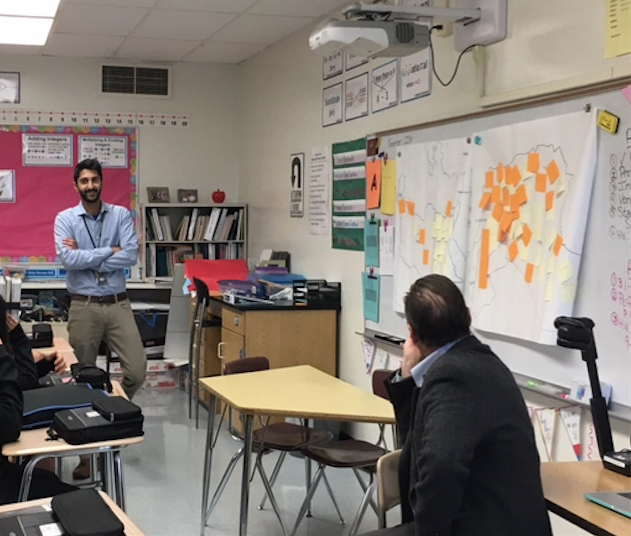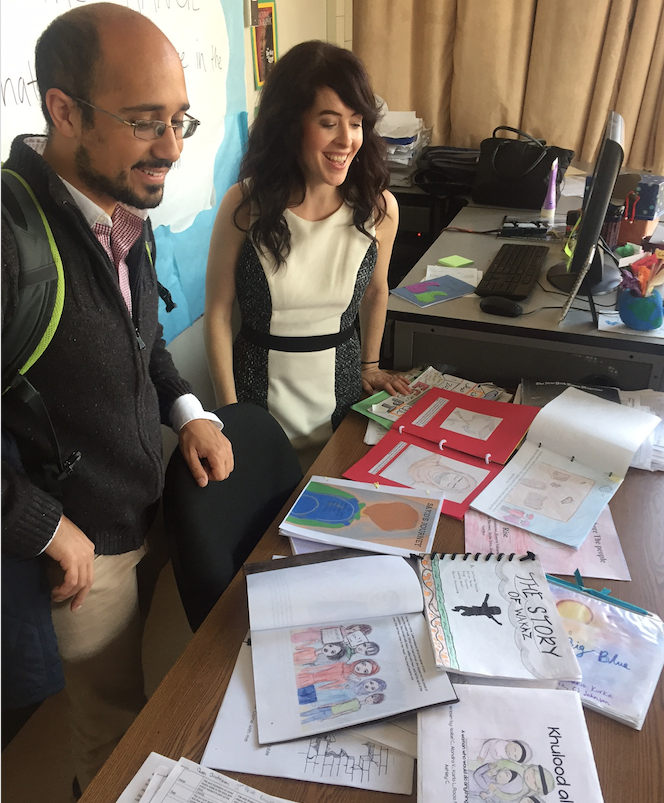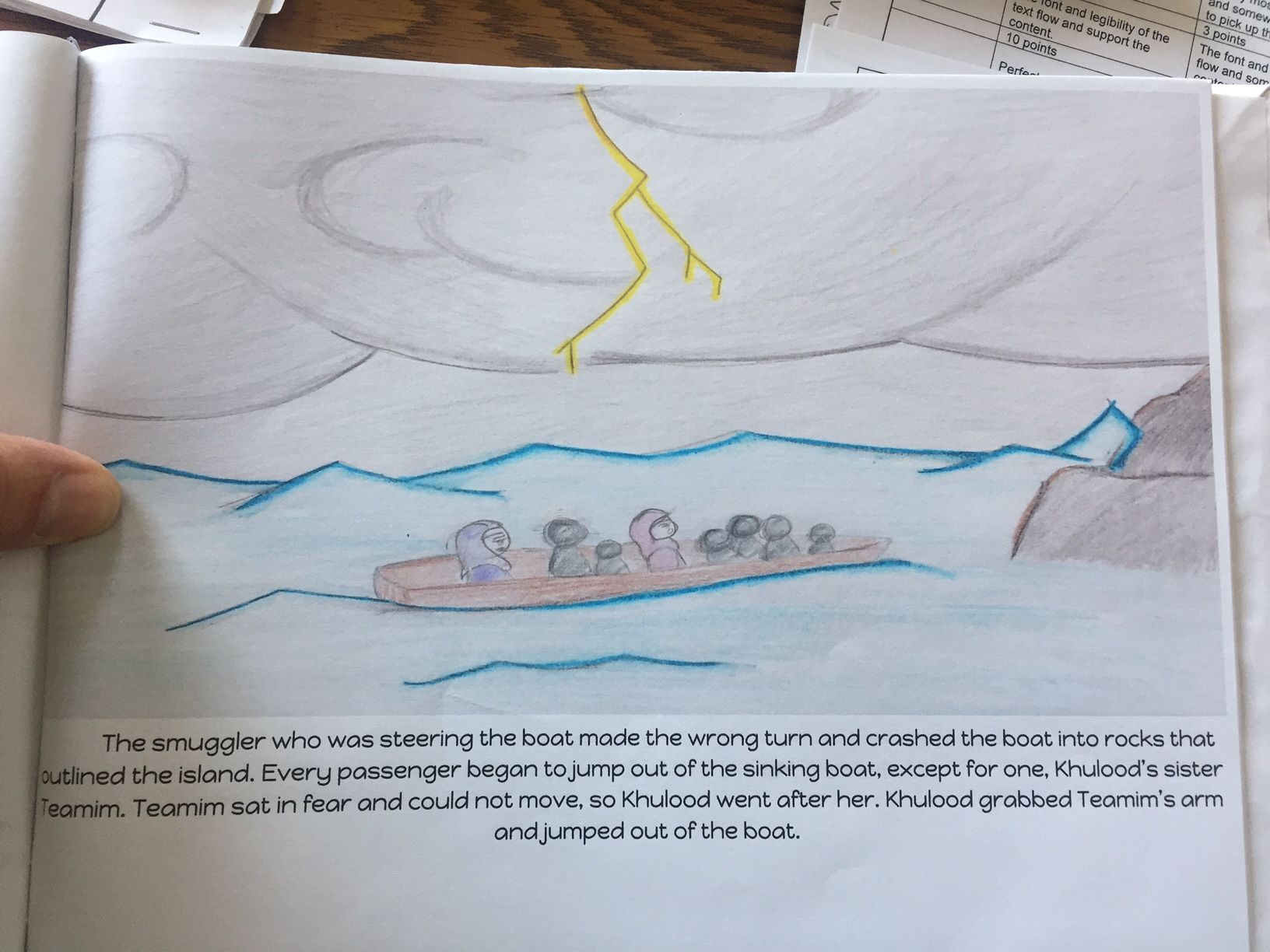“What were your thoughts and emotions when you were interviewing these people?” an eighth-grader at Holmes Middle School in Arlington Heights, IL asked Scott Anderson at the conclusion of his presentation earlier this month to her Global Studies class.
The student and her classmates had spent the past two months studying Anderson’s “Fractured Lands: How the Arab World Came Apart,” a 42,000-word story published as the entire issue of The New York Times Magazine in August 2016 that examines the stories of six people as part of an investigation into the unraveling of the modern Middle East.
“Were you scared when you were interviewing them? How do you earn their trust?” other students in the class asked.
“I develop friendships with them. I spend days with them,” Anderson replied. “There's nothing like spending time with people to help gain their trust.”
Anderson has spent the past two months visiting schools and universities as part of an expansive outreach initiative by Pulitzer Center’s education department connected to “Fractured Lands.” The initiative launched August 14, 2016, with the publishing of a K-12 lesson plan, and college-level lesson plan designed by Elon University professor Glenn Scott, that have since been viewed and modified by many thousands of educators from around the world. Over 3,000 people have gone on to connect directly with Anderson through classroom visits and public events at schools and universities. Hundreds of students have also used “Fractured Lands” in their classrooms to initiate rich explorations into the causes and human impact of the current conflicts in the Middle East.
Click here to hear directly from high school history teacher Anne-Michele Boyle, who spent the past two months using “Fractured Lands” as the guiding text for her World Studies class. Read on for a brief summary of what we hope is just the start of an exciting investigation into how this landmark story can lead to essential dialogue about the global impact of the fracturing of the modern Middle East.
University Outreach
Last month, Scott Anderson spoke with nearly 300 students and community members at two public events organized by LaGuardia Community College, a member of the Pulitzer Center Campus Consortium. He then traveled to Campus Consortium partner universities Wake Forest and Elon in North Carolina, where he met with students studying journalism, creative writing, Arabic, Middle Eastern studies and theater as part of individual class presentations and large public discussions. A discussion with Anderson and Pulitzer Center Executive Director Jon Sawyer at Wake Forest on October 26, 2016, marked the launch of the Pulitzer Center’s NewsArts initiative, which endeavors to explore the intersections of journalism and art through education programming and outreach in Winston-Salem, NC. The event was attended by over 250 people and also featured a presentation by Provost Emeritus Edwin G. Wilson.
Last week, Anderson traveled to the Campus Consortium partner University of Chicago for a series of events organized with the Institute of Politics. He spent the day speaking with students and faculty, and then participated in an evening panel discussion before a standing-room only audience of more than 125. The panel featured Pulitzer Center Executive Director Jon Sawyer and was moderated by Kerry Luft, former foreign editor for the Chicago Tribune.
“How did you get to a point in your life where you love something so much that you're willing to risk your life for it?” one audience member asked at the conclusion of the panel.
“How do you think this article challenges people's perceptions?” another audience member asked.
“It's the beginning of a conversation,” Anderson said.
“The important thing we were doing is to bear witness to the stories that were not being told. Hopefully that sparks conversation and deeper learning,” Luft added.
Click here to view the full panel.
Middle School and Secondary School Outreach
Within hours of “Fractured Lands” being published by The New York Times Magazine with a link to a lesson plan for educators teaching grades K-12, the education department was contacted by teachers from all over the world who were interested in connecting the story to their students. Sharna Marcus, a high school teacher at an international school in Even Yehuda, Israel dedicated the start of her school year to an in-depth investigation of the story that led to the production of short films. While Marcus used parts of the K-12 lesson plan designed by the Pulitzer Center education team to guide her unit, she has generously shared the lesson plan she designed for the students’ final project on the Pulitzer Center Lesson Builder.
Sven, a student in Marcus's class who is originally from Germany, wrote in his final evaluation of the project, “I learned a lot about the history of the Middle East through our group project on Laila Soueif. Focusing on the life of a person who personally experienced all the political and structural changes in the Middle East helped me get a very authentic point of view and understand the concepts and reasons behind all the different events more clearly.”
“Learning about the Middle East through the ‘Fractured Lands’ article was really beneficial,” added Debora, a student in the class who is originally from The Netherlands. “It is difficult to learn about some units through a textbook or other means of teaching because the student can't relate to the subject, but this article made it much more personal,”
While in Chicago last week, Scott Anderson was able to meet with two classes that had spent weeks studying his piece. First, he met with the eighth-grade Global Studies students at Holmes Middle School in Arlington Heights, IL. The students had worked with teacher Faraz Chaudry and Information Literacy Specialist Tracy Crowley to process the story through an in-depth analysis of the story that included extensive discussions about geography and the history of the formation of borders in the Middle East after WWI. Crowley created a digital notebook for the preface of “Fractured Lands” that offers students vocabulary support and activities to facilitate engagement with the piece. Chaudry asked students to select two characters that they would like to focus on while reading, and the students chose Syrian student Majd and former ISIS fight Wakaz. This week, students at Holmes will be processing their visits with Anderson and creating photo essays to reflect their final reflections on the story.
“Learning about Scott Anderson's process interested me the most. I was also interested in the way he choose the people he wrote about,” one student wrote in an evaluation of the visit.
“I enjoyed seeing the perspective of Scott Anderson. It gave me a whole different viewpoint on how I read the New York Times article, "Fractured Lands,” another added.
After leaving Holmes, Anderson met with nearly 300 sixth, seventh and eighth grade students at Helen Peirce Middle School in Chicago, where several students had questions about how Anderson was able to interview former members of ISIS. One student asked about how conflict in the Middle East was impacting the environment. Others were concerned about the children of Laila Soueif, who had been imprisoned by the Egyptian military.
Anderson concluded his Chicago visit with a presentation for nearly 500 students, faculty and parents at Whitney M. Young Magnet High School; 135 students had worked with the article for eight weeks as part of their World Studies classes with history teacher Anne-Michele Boyle, who led the students in several hands-on exercises to process the themes and historical context presented in “Fractured Lands. Boyle’s students started with an exercise from the Pulitzer Center’s K-12 lesson plan that asked students to examine a list of identities and rank which identities were most important to them. Students then read “Fractured Lands” using identity as a lens to connect to the characters.
Students tracked the timeline of historical events in the article by designing visual timelines that documented the events of “Fractured Lands” alongside a reflection of what American media might have been covering at the times of the events of the story. Here is a link to Boyle’s lesson plan describing the project.
After finishing the story, students reflected on the themes, characters and regions that they connected to the most throughout their investigation of “Fractured Lands,” and then used those reflections to create children’s books in small groups that were inspired by the story. Boyle designed a project description and grading rubric for students, but it is clear from the final products that all groups embraced their creativity and individual connections to the subjects of Anderson’s piece when designing their books. Several books imagined the subjects of “Fractured Lands” as children. Others featured characters that the students created to reflect the themes of the story. Students will be reading their books to local elementary schools later this year to continue the discussions ignited by “Fractured Lands” with their communities. See the images above for a few snapshots of the students’ work.
Boyle wrote a full account of her experience working with “Fractured Lands” for our blog. Sharna Marcus sent the following description of her experience with the story:
“I began the year teaching Middle East History using Fractured Lands. My impression was that the students enjoyed the process of learning about the area through contemporary and personal lenses. Their presentations indicated that they achieved the learning goals and were invested in the topic. However, actual learning is demonstrated best as it is applied after the grade book has been closed. It was only when we began the next unit did I realize the impact the Fractured Lands' piece and lessons had on my students. The second unit was on the history of Islam through the fall of the Ottoman Empire. When they were studying Islam, they weren't just studying a world religion, rather the religion of Majd Ibrahim and Laila Soueif. When they were looking into the ethnic practice of Islamic minorities, they were thinking about Dr. Azar Mirkhan. Although professionally I know the importance of the average person's story in history, I sometimes fail to provide it to my students, relying too much on the analysis of kings, autocrats and document signers. This lesson was a good reminder about the power of journalism and the individual when teaching high school history.”
The Pulitzer Center plans to continue developing partnerships and education programming to connect “Fractured Lands” to schools and communities around the world. If you are interested in connecting with us to bring this story to your classroom, email [email protected].

